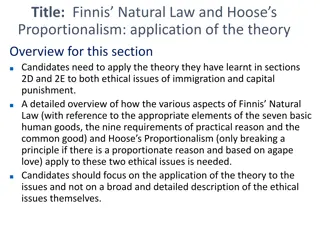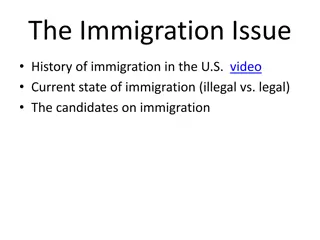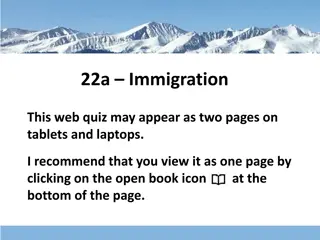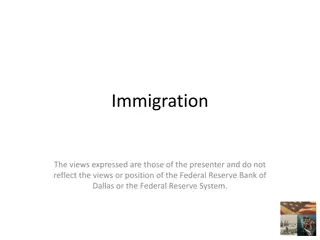Immigration Trends from 1800-1880: Factors and Impacts
Immigration to the United States from 1800 to 1880 was driven by push and pull factors such as land availability, economic opportunities, and population growth in Europe. This period witnessed different groups of immigrants, including enslaved individuals, indentured servants, Germans, Irish fleeing the potato famine, German revolutionaries, and persecuted Jews from Czarist Russia. These diverse influxes shaped the American landscape and economy during this era.
Download Presentation

Please find below an Image/Link to download the presentation.
The content on the website is provided AS IS for your information and personal use only. It may not be sold, licensed, or shared on other websites without obtaining consent from the author.If you encounter any issues during the download, it is possible that the publisher has removed the file from their server.
You are allowed to download the files provided on this website for personal or commercial use, subject to the condition that they are used lawfully. All files are the property of their respective owners.
The content on the website is provided AS IS for your information and personal use only. It may not be sold, licensed, or shared on other websites without obtaining consent from the author.
E N D
Presentation Transcript
Immigration Annotating Compare and Contrast
Annotation Review 1. Scan the text and circle vocabulary and * unknown words. 2. Write definitions in the margins. 3. Read the Text 4. Underline key points and important details. 5. Use a ? for questions during reading, write your questions in the margins. 6. Use an ! for things that surprised you, make a note. 7. Use an to show connections, TS-TT-TW-TM
Annotation Guided Practice Excerpt from: Jackdaws 620-Broadsheet 1 Introduction to immigration 1800-1880 Immigrants, people who have migrated to the United States from other countries, have always been a part of the American scene, but in some periods more people have come than in others. Total immigration to the American colonies was about 450,000 people. The first wave took place in the 17th century (the 1600s) and was composed of emigrants from England who sought to acquire land and build a better life. From 1700 to 1775, there was an extraordinary increase in population from about 300,000 to 2,500,000. Some of this increase came from an influx of people, both free and enslaved, into the flourishing colonies. The largest single group of immigrants did not come voluntarily; they were slaves from Africa who arrived in chains. Many German, English, and Scotch-Irish immigrants who arrived in the colonies and the new United States also arrived unfree. Lacking money to pay their passage or that of their families, men and women signed contracts with ship captains that sold their labor and their freedom over a period of years (usually seven) in return for the cost of the trip. Once the ship arrived in the new world, the captain would sell the contracts, called indentures, to American farmers and merchants.
Annotate with a partner Excerpt from: Jackdaws 620-Broadsheet 1 Introduction to immigration 1800-1880 Immigration was governed by both push and pull factors. The primary factors that pulled people towards the New World, especially the United States, were the availability of land, increased economic opportunities, higher wages, and greater personal and religious freedom . . . The single most important factor pushing people out of Europe was a growth in population. This sudden surplus of people led to displacement of people from rural areas to the growth of cities . . . Aside from the general factors that prompted emigration across Europe; there were particular situations that led to heavy emigration from particular places at specific times. The Irish potato famine of the 1840s led to a mass migration of people that preceded the urbanization and industrialization of the country, but followed dramatic population growth and the commercialization of agriculture. The Revolution of 1848 led to a wave of German immigrants, and the persecution of Jews in Czarist Russia swept millions of Jews onto American Shores.
Text Dependant Questions asks a question that can only be answered by referring back to the text being read. 1. Some immigrants arrived to the new United States unfree. Identify the four groups listed in the text and describe why they were unfree. 2. Describe push and pull factors and explain how they lead to immigration/emigration.
Compare and Contrast Ellis Island and Angel Island
Compare Identify how two or more things are alike.
How are the two pictures similar? Angel Island 1926 Ellis Island early 1900s
Contrast Identify how two or more things are different.
How are the two pictures different? Angel Island Ellis Island
Background Information Angel and Ellis Island video https://www.youtube.com/watch?v=vDka_SqKfN0
Ellis Island Angel Island -Came from Europe -Came from Asia -Both were main points of entry into the United States -On the East Coast -On the West Coast -22 million entered through Ellis Island - 1 million came from Asia -Both had inspection/ Interrogation process VENN DIAGRAM
Reading Texts 1. History of Ellis Island 2. History of Angel Island Closely read each text and annotate
Compare and Contrast History of Angel Island History of Ellis Island
Remaining Questions After examining the photographs, watching the video, and reading the history s, what unanswered questions do you still have.
Summary In a minimum of two paragraphs of 5 to 7 sentences each, summarize the similarities and differences between Angel and Ellis Islands, using the photographs, your notes from the video, and the texts.
Point of View The author s point of view reveals the author s beliefs, personal judgments or attitudes toward a certain subject. Questions What is the authors attitude toward the event? What is the authors bias? (prejudice in favor of or against) What is the authors background?
Explicit and Implicit Meaning in the text https://www.youtube.com/watch?v=MK1KCcwy20k
Excerpt from Mary Cone Describes the Chinaman in California JOHN CHINAMAN is too important an institution in California to be dismissed with a mere passing notice. There is no question connected with the development and present condition of the State to which the writer gave more patient and unprejudiced attention than to this. What has been the result of the immense emigration from "Central Flowery Kingdom" upon the material interests of the Pacific coast? Have these almond-eyed laborers been a help or a hinderance? Truthful answers to these questions were sought for with diligence, and every means of gaining accurate information called into requisition. Personal observation and competent testimony were arranged side by side and compared. Among intelligent men there seemed to be no great difference of opinion as to the beneficial results of their labors as railroad builders, as miners, as gardeners, as agriculturists, and as assistants in manufacturing establishments. As to their employment in any of these capacities, the verdict was almost always in their favor. That without their help in these directions the natural wealth of California could not have reached its present development in a quarter of a century to come, was generally admitted. . . . Mary Cone, a resident of Marietta, Ohio, spent two years in California. In 1876, she published Two Years in California, a book she wrote to describe her experiences.
Analyze Text 1 What is the author s point of view? Explicit evidence Implicit evidence
Excerpt from Hinton Rowan Helper on Chinese Immigration Is this Chinese immigration desirable? I think not; and, contrary to the expressed opinions of many of the public prints throughout the country, contend that it ought not to be encouraged. It is not desirable, because it is not useful; or, if useful at all, it is so only to themselves--not to us. No reciprocal or mutual benefits are conferred. In what capacity do they contribute to the advancement of American interests? Are they engaged in any thing that adds to the general wealth and importance of the country? Will they discard their clannish prepossessions, assimilate with us, buy of us, and respect us? Are they not so full of duplicity, prevarication and pagan prejudices, and so enervated and lazy, that it is impossible for them to make true or estimable citizens? I wish their advocates would answer me these questions; if they will do it satisfactorily, I will interrogate them no further. Under the existing laws of our government, they, as well as all other foreigners, are permitted to work the mines in California as long as they please, and as much as they please, without paying any thing for the privilege, except a small tax to the State. Even this has but recently been imposed, and half the time is either evaded or neglected. The general government, though it has sacrificed so much blood and treasure in acquiring California, is now so liberal that it refuses to enact a law imposing a tax upon foreign miners; and as a matter of course, it receives no revenue whatever from this source. . . they are ready to take all they can get from us, but are not willing to give any thing in return. They did not aid in the acquisition or settlement of California, and they do not intend to make it their future home. They will not become permanent citizens, nor identify their lives and interests with the country. They neither build nor buy, nor invest capital in any way that conduces to the advantage of any one but themselves. They have thousands of good-for-nothing gewgaws and worthless articles of virtue for sale, and our people are foolish enough to buy them; but their knowledge of the laws of reciprocity is so limited, that they never feel in any need of American commodities. Hinton Rowan Helper was from North Carolina. In the 1850s, he became controversial in the South because of his opposition to slavery, especially in his book The Impending Crisis. In another book, The Land of Gold, from California As I Saw It, 1849-1900, Helper set forth his views on Chinese immigration.
Analyze Text 2 What is the author s point of view? Explicit evidence Implicit evidence
References http://loc.gov/pictures/resource/cph.3a38144/ http://www.aiisf.org/education/station-history http://www.history.com/topics/ellis-island https://www.google.com Scriabine, Christine Brendel. Immigrants to a Growing Nation 1800-1880. Amawalk, N.Y.: Jackdaw Publications, 2002. Print. www.nps.gov
























